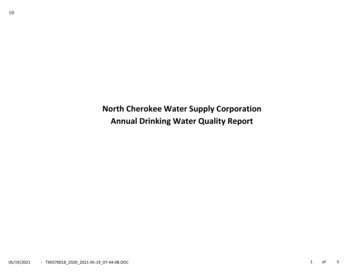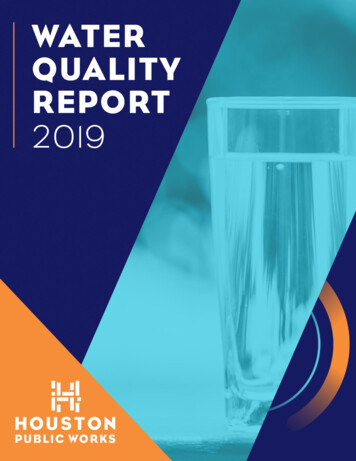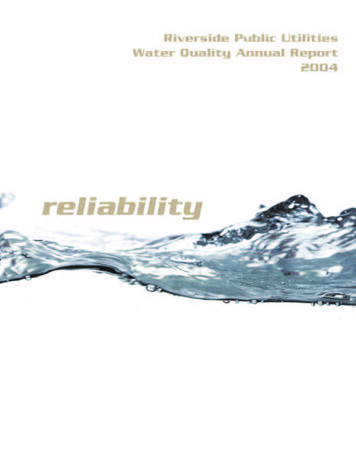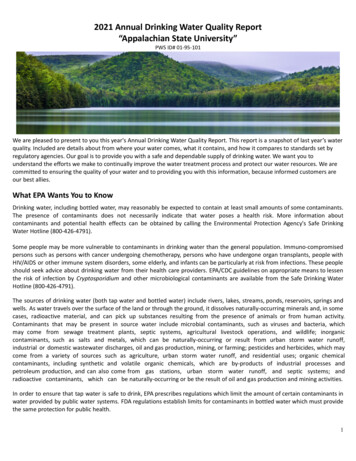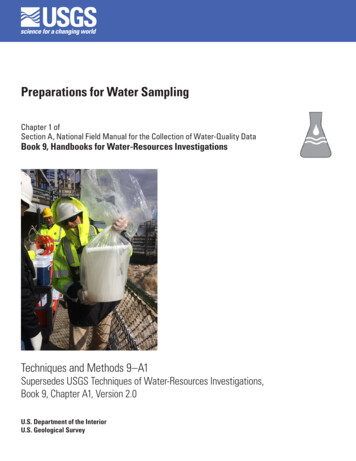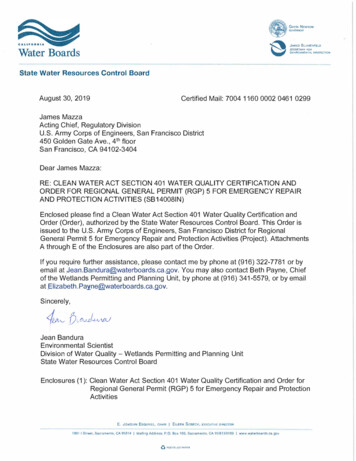
Transcription
Chester Water Authority2016 Annual WaterQuality ReportThis Water Quality Report provides informationon how the Authority operates, how we treat ourwater, and the results of the testing we performon our water. We hope you find it informative.We are proud that our water meets all state andfederal regulations.This report has been produced in accordancewith United States Environmental ProtectionAgency (EPA) and Pennsylvania Department ofEnvironmental Protection (PADEP) regulations.A short glossary has been provided on page 7 toexplain technical terms used in the report.Please share this information with other peoplewho drink CWA water, especially those who maynot have received this notice directly (for example,people in apartments, nursing homes, schools,and businesses). You can do this by posting thisnotice in a public place or by distributing copiesby hand or by mail. It is also available on ourwebsite at http://chesterwater.com/waterquality/CCR2016.pdfAt Chester Water Authority, we welcome yourquestions about the drinking water we supply.You’ll find information about contacting CWAinside this report. If you have a special healthconcern, please see the information on page 6.Este informe contiene información importanteacerca de su agua potable. Haga que alguien lotraduzca para usted, ó hable con alguien que loentienda. Las personas que tengan necesidadesmedicas especiales, por favor lean la página 6.PWS ID#1230004
About Chester Water AuthorityThe Chester Water Authority is aPennsylvania municipal authorityestablished in 1939 for the purposeof providing potable water to ourcustomers. We are a public watersupplier and not-for-profit organization.CWA has over 43,000 direct customersresiding in southwestern DelawareCounty, PA; southern Chester County,PA; and the City of Chester, PA. Wealso supply water to thousands ofadditional people through the resale ofwater to neighboring water utilities inPennsylvania and Delaware.2
Our Commitment to ExcellenceThe Chester Water Authority (CWA) is committed to supplyingits customers with high quality water and providing public healthprotection that goes above and beyond existing federal and stateregulations.In keeping with that commitment, in 1995, the Authority joinedthe Partnership for Safe Water, a voluntary effort between someof the nation’s leading drinking water organizations, including theDepartment of Environmental Protection, the U.S. EnvironmentalProtection Agency, the Pennsylvania Section American Water WorksAssociation and several other drinking water organizations.The goal of the Partnership is to provide a measure of public health protection to customersby implementing prevention programs where legislation or regulation does not exist. Thepreventative measures are based around optimizing treatment plant performance anddistribution system operation. The result is the production and delivery of superior quality waterto all users.The Chester Water Authority’s Octoraro Water Treatment Plant has received the prestigiousPhase IV, Excellence in Water Treatment Award from the Partnership for Safe Water. Phase IVrepresents the highest possible level of performance that can be achieved in the Partnership forSafe water program and recognizes performance that surpasses the required federal standardsfor water quality. The designation also indicates that Chester Water Authority’s water treatmentfacility has achieved full optimization and met all water quality and operational requirements.3
Source Water Protection Plan andSource Water AssessmentsTo protect its drinking water, Chester Water Authority worked with the Department ofEnvironmental Protection to develop a source water protection plan that was finalized in July2015. The plan is a voluntary program that will help ensure the quality of the surface water foryears to come.The goal of the Source Water Protection Plan is to better protect a valuable resource for drinkingwater, both groundwater and surface water, that is shared by all residents and businesses withinthe watershed and Chester Water Authority customers. Chester Water Authority is assisted by asteering committee of residents, township officials, and partnering stakeholders.Part of the development of the Source WaterProtection Plan was built upon the Source WaterAssessment of the Octoraro Reservoir. ThisAssessment was completed in 1988. The SourceWater Assessment indicated that the OctoraroReservoir was most susceptible to contaminationby nutrients and sediments from agriculture. Otherpotential sources of contamination include spillsfrom roads and bridges, residential and municipalwastewater treatment, urban storm water runoff andindustrial discharges.A Source Water Assessment of the SusquehannaRiver, which serves as an additional source of waterfor the Chester Water Authority, was completedin 2003. The Source Water Assessment indicatesthat this part of the Susquehanna River Basin wasmost susceptible to contamination from agriculturecontaminants, spills from roads and bridges and urban storm water runoff. Other potentialsources of contamination include discharges from wastewater treatment plants, water treatmentplants, and industry.A summary report of the Susquehanna River Basin assessment is available on the PennsylvaniaSource Water Assessment & Protection web page .Complete reports were distributed to municipalities, water supplier, local planning agencies andPADEP offices. Copies of the complete report are available for review at the PADEP SoutheastRegional Office at 484-250-5110 or by calling the Chester Water Authority at 1-800-217-7880.4
Where Does Your Water Come From?In 2016, the CWA OctoraroTreatment Plant treated andpumped an average of 30million gallons of drinkingwater each day to ourcustomers in the region.The water treated at theOctoraro Treatment Plantcomes from two sources:the Octoraro Reservoir onthe Octoraro Creek, andthe Conowingo Pool of theSusquehanna River. Bothof these sources are in theSusquehanna River Basin.The EPA and PADEP haveestablished regulationsthat require public watersystems to monitor for certaincontaminants. They have also set limits for the amounts of contaminants that may be present indrinking water.As your water supplier, we recognize that contaminants may be present in source water. We alsounderstand the responsibility we have to operate the treatment processes of the Octoraro TreatmentPlant in such a way that the finished drinking water we produce complies with all drinking waterstandards. Our mission is to provide quality water to all our customers, when they need it, at areasonable cost.Our Service AreaAston TownshipBethel TownshipBirmingham TownshipBrookhaven BoroughChadds Ford TownshipChester Heights TownshipChester TownshipCity of ChesterConcord TownshipE. Marlborough TownshipE. Nottingham TownshipFranklin TownshipKennett Square BoroughKennett TownshipLittle Britain TownshipLondonderry TownshipLondon Grove TownshipLower ChichesterTownshipLower Oxford TownshipMarcus Hook BoroughMiddletown TownshipNether ProvidenceTownshipNew Garden TownshipNew London TownshipOxford BoroughParkside BoroughPenn TownshipPennsbury Township5Thornbury Township(Chester County)Thornbury Township(Delaware County)Trainer BoroughUpland BoroughUpper ChichesterTownshipUpper Oxford Township
Substances Expected in Drinking WaterDrinking water, including bottled water, may reasonably be expected to contain at least small amounts ofsome contaminants. The presence of contaminants does not necessarily indicate that the water poses ahealth risk. More information about contaminants and potential health effects can be obtained by callingthe EPA’s Safe Drinking Water Hotline at 1-800-426-4791.The sources of drinking water (both tap water and bottled water) include rivers, lakes, streams, ponds,reservoirs, springs, and wells. As water travels over the surface of the land or through the ground, itdissolves naturally occurring minerals and, in some cases, radioactive material, and can pick up substancesresulting from the presence of animals or from human activity.Contaminants that may be present in source water include: Microbial contaminants, such as virusesand bacteria, which may come from sewagetreatment plants, septic systems, agriculturallivestock operations, and wildlife. Organic chemical contaminants, includingsynthetic and volatile organic chemicals, whichare by-products of industrial processes andpetroleum production, and can also come fromgas stations, urban stormwater runoff, andseptic systems. Inorganic contaminants, such as salts andmetals, which can be naturally-occurring orresult from urban stormwater runoff, industrialor domestic wastewater discharges, oil and gasproduction, mining, or farming. Radioactive contaminants, which can benaturally-occurring or be the result of oil andgas production and mining activities. Pesticides and herbicides, which may comefrom a variety of sources such as agriculture,urban stormwater runoff, and residential uses.In order to ensure that tap water is safe to drink, the EPA and PADEP prescribes regulations whichlimit the amount of certain contaminants in water provided by public water systems. Food and DrugAdministration and PADEP regulations establish limits for contaminants in bottled water which mustprovide the same protection for public health.Special Health ConcernsSome people may be more vulnerable to contaminants in drinking water than the general population.Immuno-compromised persons, such as persons with cancer undergoing chemotherapy, persons whohave undergone organ transplants, people with HIV/AIDS or other immune system disorders, some elderlyand infants, can be particularly at risk from infections. These people should seek advice about drinkingwater from their health care providers. Environmental Protection Agency (EPA)/Centers for DiseaseControl (CDC) guidelines on appropriate means to lessen the risk of infection by Cryptosporidium andother microbiological contaminants are available from the Safe Drinking Water Hotline at 1-800-426-4791.Alguna gente puede ser más vulnerable a los contaminantes en agua potable que la población en general. Laspersonas immunocomprometidas tales como personas con los trasplantes del órgano del cáncer que experimentan,la gente con VIH/SIDA u otros desórdenes del sistema inmune, algunos ancianos, e infantes pueden estardeterminado en el riesgo de infecciones. Esta gente debe buscar consejo sobre guías de consulta el beber en mediosapropiados de aminorar el riesgo de la infección por Cryptosporidium y otros contaminantes microbiológicos estándisponibles del teléfono directo seguro del agua potable (1-800-426-4791).6
Definitions of Terms in this Report : A symbol used to designate “greaterthan.”Minimum Residual Disinfectant Level:The minimum level of residual disinfectantrequired at the entry point to thedistribution system.%: A symbol that means “percent.”AL (Action Level): The concentration of acontaminant which, if exceeded, triggerstreatment or other requirements that awater system must follow.NA: Not applicableND: Not detectedCDC: Centers for Disease Control andPrevention.NTU (nephelometric turbidity unit): Ameasure of water clarity.EPA: United States Environmental ProtectionAgency.PADEP: Pennsylvania Department ofEnvironmental Protection.gpg (grains per gallon): A measurement ofwater hardness often used to determinedetergent requirements for dishwashersor washing machines. One grain per gallonequals 17.12 ppm (see right) of hardness.ppb (part per billion): One microgram perliter, or one in a billion. This is the relativeequivalent of one penny in ten milliondollars or one inch in 15,783 miles.ppm (part per million): One milligram perliter, or one in a million. This is the relativeequivalent of one dollar in a million dollarsor one inch in 15.8 miles.MCL (Maximum Contaminant Level):The highest level of a contaminant thatis allowed in drinking water. MCLs areset as close to the MCLGs (see below) asfeasible using the best available treatmenttechnology.source water: Water in its natural state,before it has received any treatment.MCLG (Maximum Contaminant Level Goal):The level of a contaminant in drinking waterbelow which there is no known or expectedrisk to health. MCLGs allow for a margin ofsafety.turbidity: Turbidity is a measure of theclarity or cloudiness of the water. Wemonitor it because it is a good indicator ofthe effectiveness of our filtration system.TT (treatment technique): A requiredprocess intended to reduce the level of acontaminant in drinking water.MRDL (Maximum Residual DisinfectionLevel): The highest level of disinfectantthat is allowed in drinking water. Thereis convincing evidence that addition ofa disinfectant is necessary for control ofmicrobial contaminants.umhos/cm @ 25⁰C: A measurementof conductivity which is affected bytemperature. For this reason, conductivity isreported at 25 degrees Celsius (25⁰C).MRDLG (Maximum Residual DisinfectionLevel Goal): The level of a drinkingwater disinfectant below which thereis no known or expected risk to health.MRDLGs do not reflect the benefits of theuse of disinfectants to control microbialcontaminant.watershed: The land area drained by astream or river. Any rain or snow that fallsin the watershed of a stream flows to thatstream, traveling to the stream over land orthrough the ground.7
DrinkingWaterQualityThe tables below show the regulated substances that were detected in your drinkingwater in 2016. The CWA conducted more than 61,000 analyses in 2016 of the drinkingwater we supply and we are proud that the water we supplied complied with all EPAand PADEP contaminant limits. No MCLs or Treatment Techniques were exceeded.TURBIDITYTurbidity(NTU)MCLGMCLResultRange ofResultsViolationSource ofSubstanceNATT 1 NTU for a singlemeasurement0.090.02 - 0.09NoSoil Runoff100%NANoSoil RunoffNATT at least 95% ofmonthly samples lessthan or equal to 0.3 NTUMICROBIOLOGICALMCLGMCLHighest ResultViolation0No more than 5% ofmonthly samples canbe positive0.7NoMCLGAction Level(AL)90thPercentileSamples 5NoMCLGMCLHighest ResultRange m)220.8ND - 0.8NoNitrate(ppm)10107.2ND - 7.2NoTotal ColiformsSource ofSubstanceNaturally presentin theenvironmentLEAD AND COPPERSource ofSubstanceCorrosion ofhouseholdplumbingCorrosion ofhouseholdplumbingINORGANIC CHEMICALS8Source ofSubstanceErosions ofnaturaldepositsWater additivethat promotesstrong teethSource watercontaminantfrom fertilizeruse
ENTRY POINT DISINFECTION )Lowest LevelDetectedRange ofDetectionsViolationSource ofSubstance2.02.0 - 3.1NoWater additivesto controlmicrobes0.2DISTRIBUTION DISINFECTION RESIDUALSMRDLGMRDLHighest ResultRange ofResultsViolation442.21.8 - 2.2NoChloramine(ppm)Source ofSubstanceWateradditivesto controlmicrobesDISINFECTION BYPRODUCTSMCLGMCLHighestResultRange 2 - 74NoHaloacetic Acids(ppb)NA604218 - 54NoSource ofSubstanceBy-product ofdrinking waterchlorinationBy-product ofdrinking waterdisinfectionTOTAL ORGANIC CARBON (TOC)MCLGTOC(ppm)NA% RemovalRequiredMCLTT% RemovalAchieved25 - 35Number ofQuartersOut ofCompliance26 - 52ViolationSource ofSubstanceNoNaturallypresentin theenvironment0SYNTHETIC ORGANIC CHEMICALSAtrazine(ppb)MCLGMCLHighest ResultRange ofResultsViolation330.24NANo9Source ofSubstanceRunoff fromherbicide usedon row crops
Other 2016 Water Quality DataAs part of our ongoing commitment to provide our customers with accurate and reliableinformation, the Chester Water Authority is pleased to share additional water quality data.The data provided in the chart below represents water quality that we provided to youthroughout onia0.5ppmChloride39ppmConductivity340umhos/cm H 33ppmTotal Solids230ppmSUBSTANCE10
About Fluoride in Drinking WaterFluoridation of drinking water has been endorsed by the American Dental Association (ADA) since 1950because of the public health benefit that fluoridation provides in preventing tooth decay. The Centersfor Disease Control (CDC) considers drinking water fluoridation one of the ten great public healthachievements of the twentieth century. In 1968, Chester Water Authority received a permit from PADEPto fluoridate. In January 2011, the U.S. Department of Health and Human Services and EPA recommendeda maximum fluoride level of 0.7 ppm. CWA water contained an average of 0.6 ppm of fluoride in 2016.For more information on infant formula and fluoride, refer to CDC at www.cdc.gov andADA at www.ada.org.CryptosporidiumCryptosporidium is a microbial pathogen found in surface water throughout the U.S. In 2016, wemonitored our Octoraro and Susquehanna source waters for Cryptosporidium. Cryptosporidium wasdetected in our Susquehanna source in one monthly sample in 2016. Although our treatment processincludes filtration to remove Cryptosporidium, the most commonly-used filtration methods cannotguarantee 100 percent removal. Current test methods do not allow us to determine if the organisms aredead or if they are capable of causing disease.Ingestion of Cryptosporidium may cause cryptosporidiosis, an abdominal infection. Symptoms ofinfection include nausea, diarrhea, and abdominal cramps. Most healthy individuals can overcome thedisease within a few weeks. However, immune-compromised people, infants and small children, andthe elderly are a greater risk of developing life-threatening illness. We encourage immune-compromisedindividuals to consult their doctor regarding appropriate precautions to take to avoid infection.Cryptosporidium must be ingested to cause disease, and it may be spread through means other thandrinking water.NitratesNitrate in drinking water at levels above 10 ppm is a health risk for infants less than six months of age.High nitrate levels in drinking water can cause blue baby syndrome. Nitrate levels may rise quickly forshort periods of time because of rainfall or agricultural activity. If you are caring for an infant, you shouldask advice from your health care provider.Information About LeadIf present, elevated levels of lead can cause serious health problems, especially for pregnant womenand young children. Lead in drinking water is primarily from materials and components associatedwith service lines and home plumbing.CWA is responsible for providing high quality drinking water, but cannot control the variety ofmaterials used in plumbing components. When your water has been sitting for several hours, you canminimize the potential for lead exposure by flushing your tap for 30 seconds to two minutes beforeusing water for drinking or cooking.If you are concerned about lead in your drinking water, you may wish to have your water tested.Information on lead in drinking water, testing methods, and steps you can take to minimize exposure isavailable from the Safe Drinking Water Hotline at 1-800-426-4791 or at www.epa.gov/safewater/lead.11
For More InformationIf you would like more information regarding the Chester Water Authority, please contact ourCustomer Service Department at 610-876-8181 or 800-793-2323, or visit our web site atwww.chesterwater.com.If you have a specific concern or question regarding water quality, you may contact the CWA WaterQuality Laboratory during normal business hours at 800-217-7880.Meetings of the Chester Water Authority Board of Directors are held the third Thursday of everymonth at 2:00 pm at Neumann University, One Neumann Drive, Aston, PA 19014. Notice of anychanges will be made publicly available prior to the meeting. Please call 610-876-8185 extension 1219to find out exact location on the Neumann campus.Information about the Octoraro Watershed Association may be obtained by contacting them directlyat 517 Pine Grove Road, Nottingham, PA 19362, or by calling 717-529-2132.415 Welsh Street Chester, PA 19013Web: www.chesterwater.comChester Water AuthorityWalk-in: 9:00 AM to 5:00 PM Monday through FridayDrive-thru: 8:00 AM to 5:00 PM Monday through FridayTelephone: 8:00 AM to 6:00 PM Telephone: 610-876-8181 800-793-2323Emergencies: 24 HOURS PER DAY 7 DAYS PER WEEK Telephone: 610-876-8181
2015. The plan is a voluntary program that will help ensure the quality of the surface water for years to come. The goal of the Source Water Protection Plan is to better protect a valuable resource for drinking . water, both groundwater and surface water, that is shared by all residents and businesses within
